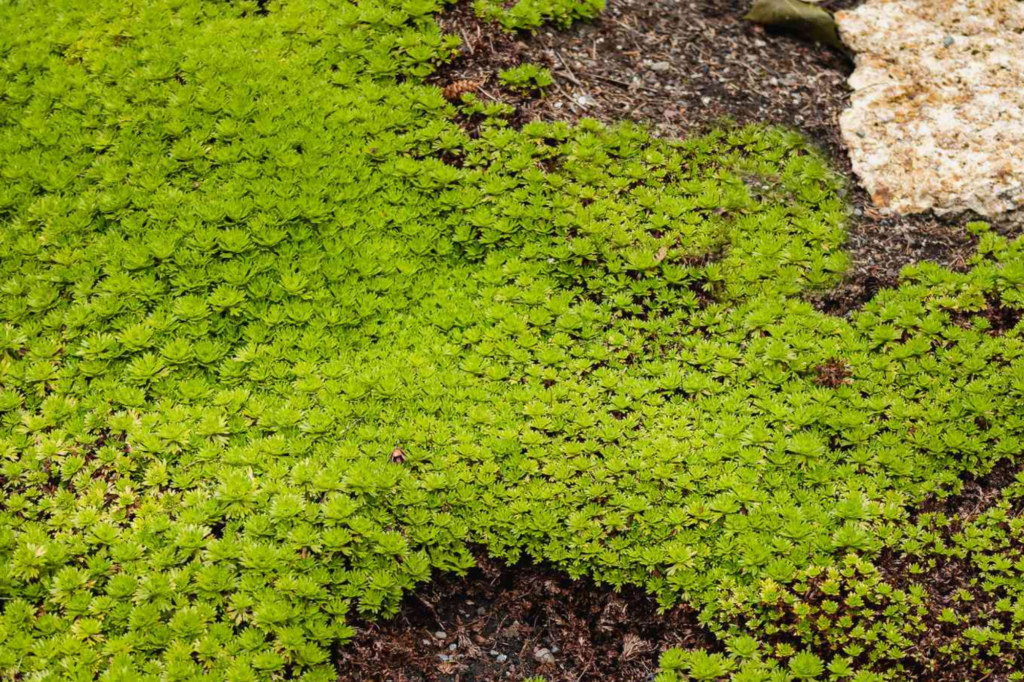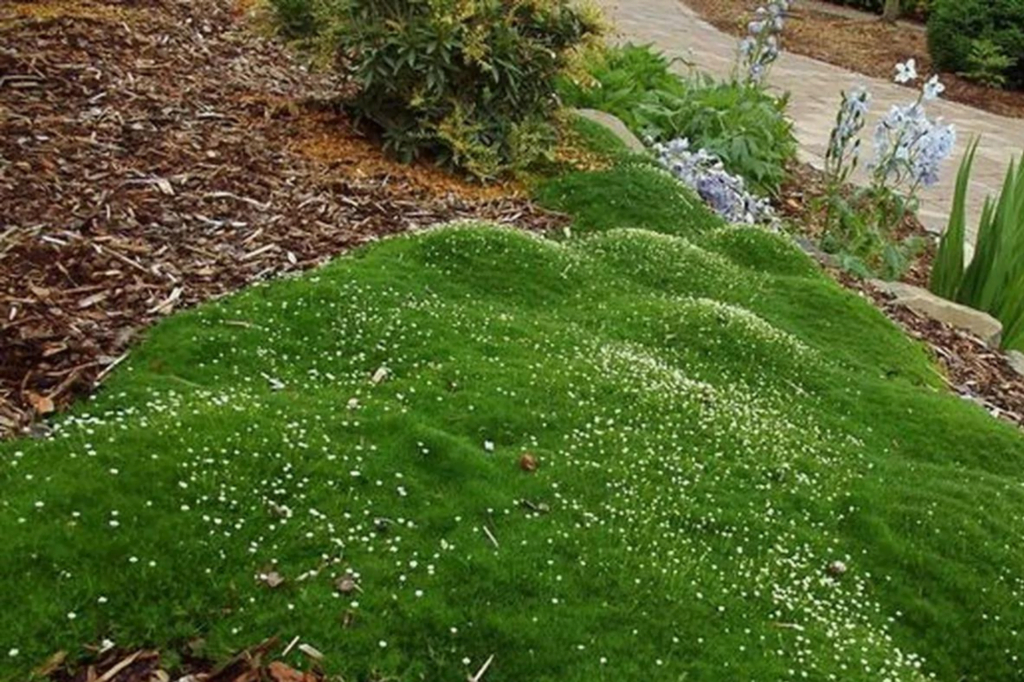When it comes to adding a splash of verdant vitality to garden landscapes, Scotch Moss and Irish Moss are two popular options that gardeners have at their disposal. Although they share some similarities, these types of moss are fundamentally different in appearance, growth patterns, and overall usefulness.
In this section, we will delve into Scotch Moss Vs Irish Moss, examining the benefits, uses, and characteristics of each. We will also explore how these mosses can be utilized in landscaping projects to create a lush and visually appealing green carpet.
What is Scotch Moss?
Scotch Moss, also known as Sagina subulata, is a low-growing perennial plant that belongs to the Caryophyllaceae family.
One of the main benefits of Scotch Moss is its versatility. It can be planted in various conditions, including full sun or partial shade, and is resistant to drought, making it a low-maintenance option for gardeners. Scotch Moss is often used as a ground cover, as it forms a dense mat of lush green foliage.
Characteristically, Scotch Moss has small, star-shaped white flowers that bloom in the summer, adding an extra visual element to its lush green carpet. The plant grows up to 1 inch tall and can spread up to 12 inches wide.
Scotch Moss is mainly used for its aesthetic appeal. It can be used to create a beautiful green carpet in walkways, rock gardens, or other landscaping projects. It also goes well with other plants and can be used to create a striking contrast with dark-colored foliage.
What is Irish Moss?
Irish Moss, also known by its scientific name Chondrus crispus, is a type of red algae that grows abundantly along the rocky Atlantic coasts of Europe and North America. Unlike Scotch Moss, which is a flowering plant, Irish Moss is an aquatic species.
Irish Moss is commonly used in the culinary industry as a natural thickener and emulsifier. It is also a popular ingredient in skincare products due to its high concentration of vitamins and minerals, including calcium, magnesium, and iodine.
Aside from its practical uses, Irish Moss is also known for its aesthetic appeal. Its vibrant green color and delicate, feathery texture make it a coveted addition to many garden landscapes.
Irish Moss prefers cool temperatures and moist, shady environments. It can thrive in a variety of soil types, including sandy or rocky soil, and is commonly found growing along the edges of streams, rivers, and ponds.
Similar to Scotch Moss, Irish Moss is a low-growing plant that forms a dense, cushion-like mat, creating a lush green carpet effect. It is also known for its ability to prevent soil erosion and retain moisture, making it an ideal ground cover for steep slopes and rocky terrain.
Some benefits of Irish Moss include:
- Can improve digestive health due to its high concentration of fiber and prebiotics.
- May help boost the immune system due to its anti-inflammatory and antimicrobial properties.
- Can aid in skin health by improving hydration and reducing inflammation.
- May help regulate thyroid function due to its high iodine content.
Irish Moss Characteristics
Irish Moss has the following notable characteristics:
| Characteristics | Description |
|---|---|
| Scientific Name | Chondrus crispus |
| Growth Habit | Low-growing, forms a dense mat |
| Color | Vibrant green |
| Texture | Delicate, feathery |
| Sunlight Needs | Partial to full shade |
| Soil Needs | Moist, well-draining, rocky or sandy |
| Climate Tolerance | Cool temperatures, humid environments |
Irish Moss has been a favorite of gardeners for centuries due to its unique aesthetic qualities and practical benefits. Its ability to add visual interest while also improving soil health and preventing erosion make it a valuable addition to any landscaping project.
Differences between Scotch Moss and Irish Moss
While Scotch Moss and Irish Moss may have similar names and appearances, there are notable differences between the two.
One significant difference is their origin. Scotch Moss, also known as Sagina subulata, originates from Europe, while Irish Moss, or Chondrus crispus, is native to the Atlantic coasts of Europe and North America.
Another difference is their growth pattern. Scotch Moss grows in a mat-like pattern that hugs the ground, while Irish Moss grows in clumps that can reach up to 6 inches in height.
Additionally, Scotch Moss has a brighter green color, while Irish Moss has a darker, almost purplish hue.
When it comes to ideal growing conditions, Scotch Moss prefers moist soil and partial shade, while Irish Moss thrives in cool, damp conditions with full sun or partial shade.
While both types of moss can be used as ground cover, Scotch Moss is often preferred for landscaping due to its ability to form a dense green carpet and withstand foot traffic.
Overall, while Scotch Moss and Irish Moss may look similar, their differences in origin, growth pattern, color, and ideal growing conditions make them unique in their own right.
Best Uses of Scotch Moss and Irish Moss in Landscaping
Scotch Moss and Irish Moss are low-growing groundcovers that can create a lush green carpet effect in garden landscapes. Their dense and compact growth habits make them ideal for filling in gaps between stones, pavers, and walkways.
Both Scotch Moss and Irish Moss can tolerate light foot traffic, making them an excellent choice for creating green paths or lawns in areas where traditional grass cannot grow.
Additionally, their adaptability to different growing conditions allows them to thrive in various garden styles and themes.
Here are some of the best uses of Scotch Moss and Irish Moss in landscaping:
- Rock gardens: These mosses make an excellent complement to rock gardens, giving a soft and gentle contrast to hard and uneven surfaces. Plant them next to or between rocks, and let them grow into a natural and harmonious pattern.
- Water features: Scotch Moss and Irish Moss can thrive in and around water features such as ponds, streams, and fountains, creating a serene and tranquil atmosphere. They can also cover areas with excessive moisture, preventing soil erosion and promoting healthy growth.
- Green roofs: These mosses are often used to create green roofs, which not only add aesthetic appeal but also provide insulation, reduce energy costs, and improve air quality.
- Container gardens: These mosses can be grown in containers, hanging baskets, and window boxes, adding a touch of greenery to balconies, patios, and other small spaces.
Frequently Asked Questions (FAQ) about Scotch Moss and Irish Moss
Have some burning questions about Scotch Moss and Irish Moss? Here are some answers to help clear things up.
What is the difference between Scotch Moss and Irish Moss?
While both Scotch Moss and Irish Moss are varieties of moss, they are actually different species. Scotch Moss, also known as Sagina subulata, is a low-growing groundcover with tiny star-shaped flowers. Irish Moss, also called Chondrus crispus, is a type of seaweed that grows in rocky, coastal areas and is often used in food products.
Is Scotch Moss or Irish Moss better for landscaping purposes?
Both Scotch Moss and Irish Moss can be great additions to landscaping projects, but their ideal uses may differ. Scotch Moss is better suited for areas with moderate foot traffic, while Irish Moss can handle heavier foot traffic. Additionally, Scotch Moss prefers slightly drier conditions, while Irish Moss thrives in moist soil.
What are the benefits of using Scotch Moss or Irish Moss in my garden?
Scotch Moss and Irish Moss can provide many benefits for your garden. These mosses are low-maintenance groundcovers that require little watering or fertilizing. They can also help control soil erosion and add a vibrant green color to your garden landscape.
Can Scotch Moss or Irish Moss grow indoors?
While Scotch Moss and Irish Moss are typically used for outdoor landscaping, they can be grown indoors as well. These mosses prefer bright, indirect light and slightly moist soil. However, they may not grow quite as well indoors as they would outdoors.
How do I plant Scotch Moss or Irish Moss?
Scotch Moss and Irish Moss can be planted by seed or through division of existing plants. These mosses should be planted in well-draining soil in an area that receives partial shade to full sun. Keep the soil slightly moist as the moss becomes established.
Can Scotch Moss or Irish Moss be harmful to pets or children?
Scotch Moss and Irish Moss are generally non-toxic and safe for pets and children. However, it’s always a good idea to supervise children and pets while they are playing in the garden, as ingestion of large amounts of any plant material can be harmful.











